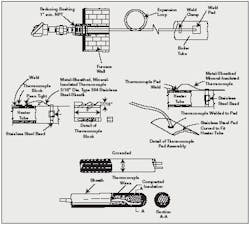The application of thermocouples
We are experiencing tube skin thermocouple failures in fired heaters. The skin thermocouples used are K-type (wire gauge 13AWG), mineral-insulated with sheath material of SS 446 (3/8-in. OD & 1/16-in. sheath thickness). Out of the 16 thermocouples installed in one of the heaters, seven of the skin thermocouples became faulty within three months of installation. One thermocouple became bad, and the second one is erratic immediately after turnaround. Four thermocouples are giving erratic readings after an upset in the heater. Skin temperatures dropped from the normal operating of about 925 °F to 596 °F; then rose to 1003 °F in six minutes; then dropped again to 500 °F in another eight minutes.
After a second heater trip, the seventh thermocouple failed.
- What is the experience with N-type thermocouples? Are they field-proven for five years of trouble-free operation?
- What type of sheath material is best suited with N-type thermocouples?
- Is K-type with Nicrobell alloy-sheathed tube skin thermocouple suitable for five years of trouble-free operation in heaters with skin temperature of around 1000 °F to 1050 °F?
- How is the performance of K-type thermocouples with Inconel sheaths?
- Are there any other better-proven skin type thermocouples for the above service?
Ahmed S.Mohideen, Instrument Design Engineer, Shuaiba Refinery, KNPC, Kuwait
ANSWER:
As shown in Figure 1 below, when the surface temperature of tubes is being measured, the thermocouple must always be shielded from furnace radiation. The thermocouple can be attached to the heater tube surface by being furnished with stainless-steel welding pads or by the use of thermocouple attachment blocks. In your application, I would use the attachment blocks, which are provided with multiple holes, allowing the quick replacement for spare thermocouple elements. FIGURE 1: THERMOCOUPLE PROTECTIONI assume that your thermocouples are grounded and installed as shown in Figure 1. The thermal time constant of the grounded junction design is shorter (by a few seconds, depending on mass) than that of the ungrounded.
Chromel-alumel (type-K) can be used in oxidizing atmospheres. It is the most linear thermocouple in general use. Type-N (Nicrosil versus Nisil) is a relatively new base-metal thermocouple. It provides stability as good as the more expensive noble metal thermocouples up to about 2200 °F (1204 °C), where type-K starts to become unstable. The stability of type-N thermocouples is due to increased percentages of chromium, silicon and magnesium.
I understand that in your application the TC is manufactured with a protective outer sheath that uses an insulating material to electrically separate the TC from the sheath and provide mechanical and environmental protection. I also assume that the TC is grounded, and the TC junction is placed in direct contact with the tip of the sheath to increase speed of response. Even insulated TCs will eventually suffer from a breakdown of the insulation. It is virtually assured that a ground loop will develop that will cause measurement errors. These errors are usually insidious in that they usually vary over time and may go unnoticed. Recommended practice is to always use an instrument with full isolation to eliminate this concern.
|
Download these PDFs >> Forward Modelling Controller |
The sheath material can be 304 stainless steel if the process temperature is under 1650 °F (900 °C), and the process is not highly corrosive. In furnaces that operate at up to 2100 °F (1150 °C), Inconel 600 sheathing is recommended if the atmosphere is oxidizing, and there is no sulfur in the atmosphere. Platinum-rhodium alloy sheaths are used up to 3000 °F (1650 °C) in oxidizing furnaces if no silica or halogens are present. Molybdenum sheaths can be used up to 4000 °F (2205 °C) to detect molten metal or glass temperatures, but only in oxygen-free vacuum or inert-gas-filled processes. Tantalum sheaths can be used up to 4500 °F (2482 °C), but only in reducing or noble gas atmospheres where no oxygen is present.
Béla Lipták



